Before the days of vitamins, multinational drug/chemical companies, and factory farming, homesteaders headed out to the woods and fields as soon as the spring turned to gather tender wild greens to eat.
Wild greens, collectively known as “greens”, “Potherbs”, and “spinach” had to be gathered while they were still young and tender because as they matured, and sent up their flower stalks, they became tough and bitter.
In my area the “wild asparagus” is mythic. Old-timers still comb the hills around Grand Forks, and up the North Fork looking for the green budding stalks as they peep up above the grass. Looking beyond asparagus, there are many other wild greens and herbs that you will find growing in the fields and gardens around you. Have you given foraging for weeds a try?
Most of these plants we call weeds came to North America from Europe at the time of the settlers and were seeded in the pastures on purpose to provide hardy spring food and herbal remedies. Wild greens are coveted for their hardiness and early Spring growth. Get to know the wild greens near you, and learn to identify them, so that you can increase your self-reliance and improve your health.
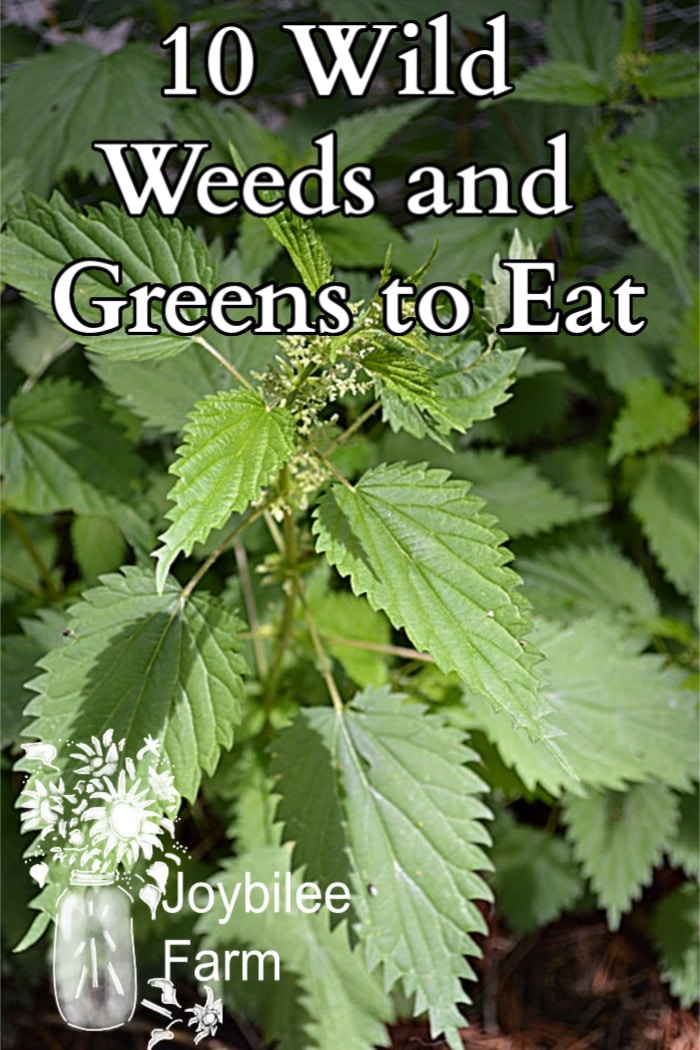
Think Before You Remove Weeds
Don’t be in a hurry to weed wild greens out of your garden with a hoe. Allow a patch or two to grow wild outside of your vegetable beds. You will find that they enrich your pastures with their seeds.
If you do need to weed out young plants, toss them to your chickens, ducks, and sheep, rather than letting them wilt on the path. These wild greens will provide valuable minerals and vitamins for your animals after a winter on hay and feed store fare.
Tips for Foraging Wild Greens
- Don’t harvest Spring wild greens next to the roadside or where you don’t know if they’ve been sprayed. These will certainly contain roadside contaminates and may have been touched by spray-drifted from a neighbour.
- Harvest wild greens where they grow, in the wild, away from roadsides.
- If you are harvesting on someone else’s land, always ask permission.
- Always be certain that you know what you are harvesting. If you are uncertain, skip it.
- Don’t take more than you need. Leave some for others and for nature to multiply.
- Even highly urban areas may have wild areas where it is permissible to gather.
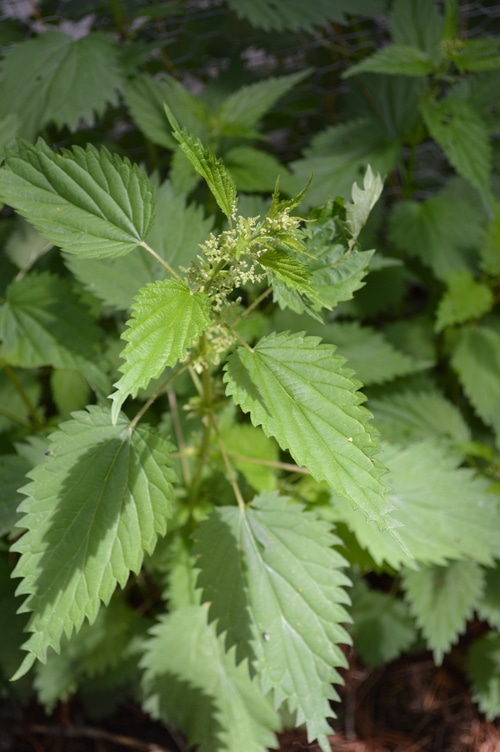
10 Wild Weeds and Greens to Eat
1. Stinging Nettle (Utica dioica, or U. chamaedryoides)
Stinging nettle a choice wild green full of minerals and is a natural spring tonic. It is a weed of damp, rich soil. It thrives where animals walk down to the creek to drink or where livestock used to loiter. Stir up an old barnyard or horse pasture and the nettles will abound. Nettles are rich in vitamin C and A, very high in protein, and support the liver. Wear strong gloves when you gather them.
They should be gathered when the shoots are young when the stems are only 6 inches high. Stinging Nettle will give you two gathering periods. Once in the Spring and again in the Fall. Nettles are perennial, so if you can get a clump established, don’t pull them up by the roots but rather clip them off with pruning shears, near the ground and they will keep growing year after year. Nettles propagate by root runners, so pull the nettles that grow too vigorously to keep control.
You can dry them for tea, year-round or cook them like spinach, pour off the cooking water and rinse. Once they are dried or cooked the sting is gone. Don’t eat them raw.
If you do get stung, while you are picking nettle tops, find a burdock or plantain plant, mash up a leaf and apply it to the sting and it will relieve the pain and itch and reduce the swelling.
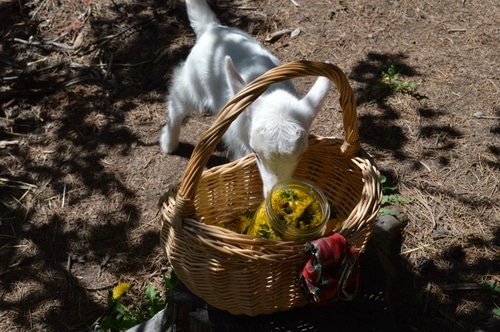
2. Dandelion (Taraxacum officinale)
Dandelion is my favorite wild green. The yellow flowers are one of the first Spring flowers and they light up the short pasture grass like a thousand suns after the winter snow recedes.
The first leaves of dandelion should be gathered before the flowers show their sunny faces. Dandelion leaves are tender with only a hint of bitterness in the early spring. Once the flower stock emerges the leaves get tougher and more bitter. Rabbits love them all summer long, even when they are bitter, so don’t toss the weeds. Feed them to your livestock, when they are past their prime for human consumption.
Dandelion is a liver tonic and eating the greens in Spring supports the immune system and cleanses the body. They are rich in iron, potassium, and vitamin C. Leaves, flower buds, flowers, and roots are all harvested for food and drink, at the appropriate time of year.
- Young wild greens can be added to salad and taste much like radicchio. Cook older dandelion greens like spinach and discard the first cooking water to get rid of bitterness. Use as you would cooked spinach in cheese and egg dishes.
- Dandelion flower buds are added to soups and omelets. Stir fry them in fat before adding to your dish.
- Open flowers can be used to make wine for winter medicines. This is the recipe that we use. It makes 1 gallon of wine or 5 750 ml bottles.
In the Fall gather the roots from your dandelions. After a full summer of growth, they will have lots of good immune-boosting qualities. These roots are a support to the liver and help rid the body of toxins, wash them well. Then split, chop, and dry them.
Dandelion roots can be roasted and used as a coffee substitute, or they can be used in tea. They are strongly diuretic, but being rich in potassium they are ideal for keeping your body in balance.
3. Dock (Rumex crispa)
Dock is a broadleaf wild green, that grows in fields, yards, and around barns. It grows about 12 to 18 inches high and its leaves are 6 to 8 inches long, they have crinkly edges. Flowers will appear in June, followed by seeds that turn dark brown. There are several species of dock and all are edible when the leaves are young. They are rich in vitamin A and C and the dark green spring leaves purify the blood and cleanse the body of toxins.
To cook Dock, boil the leaves in water and discard the cooking water. Rinse under running water and then add to your casserole or serve with other greens, adding saturated fat, and caramelized onions or roasted garlic.
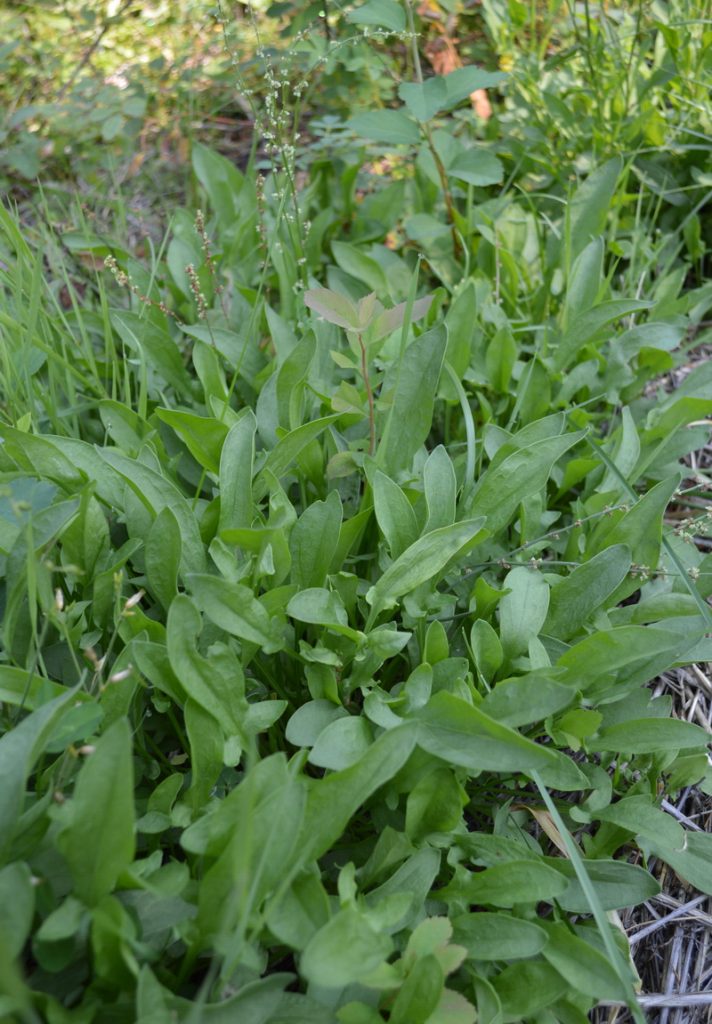
sheep sorrel in the garden
4. Sheep Sorrel (Rumex acetosella)
Sheep sorrel or sour dock is a wild green found in the fields and gardens of disturbed land. It has fine green leaves and will send up a fine flowering stock with many tiny red flowers. It spreads with creeping roots and is one of the easiest wild weeds to eat.
The leaves are arrow-shaped and have reddish stems. The leaves taste lemony and add a pleasant, sour taste when mixed in a salad or added to other cooked greens.
Used medicinally, a poultice of the leaves can be used to bind up boils. The leaves are best used when young, raw in a salad or cooked like spinach. They add a lemon-like taste and can be chopped up with green onions and added to mashed potatoes.
5. Pig Weed (Amaranthus hybridus)
It’s easy to mix up Pigweed, Lamb’s Quarters, and Strawberry Blight, so get a good field guide to common weeds to distinguish these plants as you are learning what the young spring leaves look like.
Pigweed is in the Amaranth family and related to lambs quarters, and quinoa. It is an annual plant that grows one to 8 feet tall. The leaves, stems, and roots are bright red. Pigweed, like all amaranths, has a mild flavour. You can cook the leaves like spinach, or add them to a salad with other wild greens.
The seeds can be gathered, dried, and cooked like quinoa or rice. Rinse them well to wash off the saponin before cooking. If you do not rinse the seeds will have a soapy, bitter taste. Boil one cup of seeds with two cups of water and cook like white rice.
6. Chick Weed (Stellaria media)
Chickweed is an evergreen wild green, and can often be found in winter, under the snow. It is an annual that grows 8 inches high and creeps along the ground. The whole plant is edible before flowering. Because chickens and ducks love it, it makes a good feed for them after a long winter without greens. Chickweed is a good source of vitamin C and can be used in salads or as a potherb.
It is often used as medicine and can be dried for tea. This natural remedy and is useful for relieving the pain of arthritis and to treat cuts, wounds, and other irritations of the skin.
7. Lambs Quarters (Chenopodium album)
Another wild green related to Amaranth and quinoa, lambs quarters grow in rich gardens and well-fertilized pastures. The spring leaves are scalloped and frosted. Its leaves are mealy in texture. A wild green similar to spinach in texture and taste, it’s rich in iron and potassium. The whole plant can be used if it’s under 6 inches high. Cook Lambs Quarters like spinach or use the young leaves raw in a salad.
If you’re growing quinoa or one of the flowering amaranths, and plan to save the seed for next year, don’t allow lambs quarters to go to seed. Lamb’s Quarters will cross with quinoa and some varieties of amaranth.

This is a quinoa plant. It looks like lamb’s quarters when it’s young.
8. Strawberry Blight – (Chenopodium capitatum)
Another relative of the quinoa, strawberry blight, or strawberry spinach was grown in monastery gardens in Europe. It looks like lambs quarters when young, but its leaves that are reddish on the underside and frosted on top, give it away.
Harvest the leaves of Strawberry Blight when they are young and tender. Allow the plant to mature and you can harvest the bland, red fruit to add to salads. You can buy seeds for this one in several seed catalogs.
9. Purslane – (Portulaca oleracea)
A common weed in gardens and cultivated fields, purslane grows like chickweed, flat on the ground, with thick stems and small, pinkish leaves. The whole plant is edible before flowering. Rich in vitamin C, you can add young shoots to soups and casseroles. It has a bland taste.
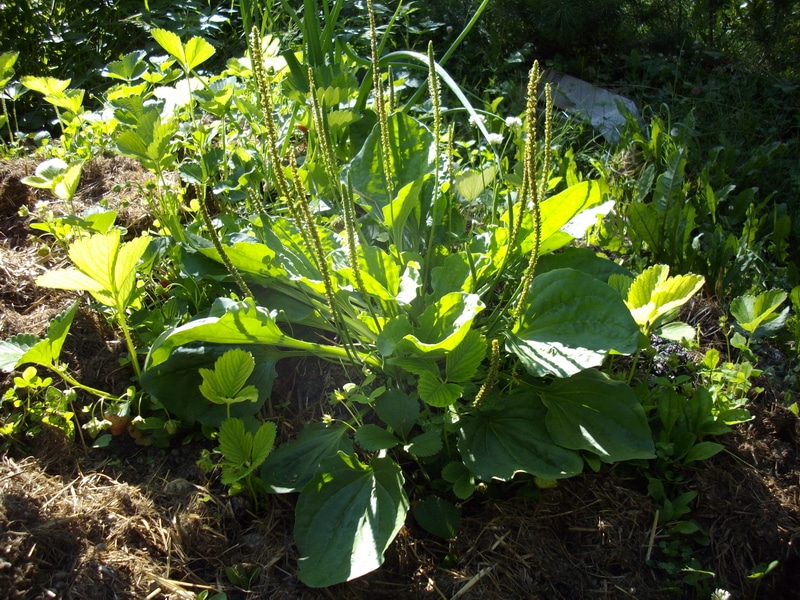
a flowering plantain plant
10. Plantain – (Plantago major)
Broadleaf Plantain and narrow leaf plantain (Plantago lanceolata) are both edible wild plants that are easy to recognize. You’ll find this one around the same places that nettles grow, note its location when you harvest nettles so that you can use a leaf, as needed, to relieve the sting of nettles.
Plantain grows in moist soil and in many gardens and is recognizable it with the round basal leaves that are ribbed. The leaves are rich in calcium, vitamin A and C. Harvest the leaves before flowering for eating as a potherb, be sure to wash the leaves and remove the stems.
Older plantain leaves will be quite stringy when raw. Overcome this by doing a parboil for 15 min. to lessen the stinginess, then drain and rinse. Boil again or fry in saturated fat.
There are Many More Wild Weeds to Eat
This is not an exhaustive list of edible wild plants that you might enjoy in your area. Depending on where you live, the choices available to you may be different than what is available to me. If you are new to eating wild weeds, the business of foraging wild greens without identifying them first with a field guide is risky. Some wild plants are intensely poisonous and even to touch it to your lips can mean certain death. So please get a reliable field guide and consult it when you go out in the woods or fields to harvest wild food.
Once you’ve seen a few plants in the wild and clearly identified them, you won’t have any doubt next time you see them. If you find something you can’t identify, leave it alone, until you can. Try these other articles for Joybilee Farm and learn about growing and harvesting perennial greens and vegetables on the homestead.
5 Edible Wild Plants of Early Spring to Hunt on Your Foraging Hike
Domesticating wild fruit to fool Mother Nature
How to Eat a Wild Rose: Roses for food and medicine
Growing Onions and Chives for Perennial Greens
6 Perennial Vegetables to Grow in Zone 3 For the Earliest Spring Greens
Double your harvest: Grow a ½ ton of food in 200 square feet from one planting
Some field guides that I’d recommend for finding edible wild plants:
Edible Wild Plants: A North American Field Guide to Over 200 Natural Foods
Edible Wild Plants: A North American Field Guide
The Everything Guide to Foraging: Identifying, Harvesting, and Cooking Nature’s Wild Fruits and Vegetables (Everything Series)
The Complete Guide to Edible Wild Plants, Mushrooms, Fruits, and Nuts, 2nd: How to Find, Identify, and Cook Them (Guide to Series)
The Forager’s Harvest: A Guide to Identifying, Harvesting, and Preparing Edible Wild Plants
Nature’s Garden: A Guide to Identifying, Harvesting, and Preparing Edible Wild Plants
Back to you:
What are your favorite edible wild plants to harvest in the Spring and where do you find them?


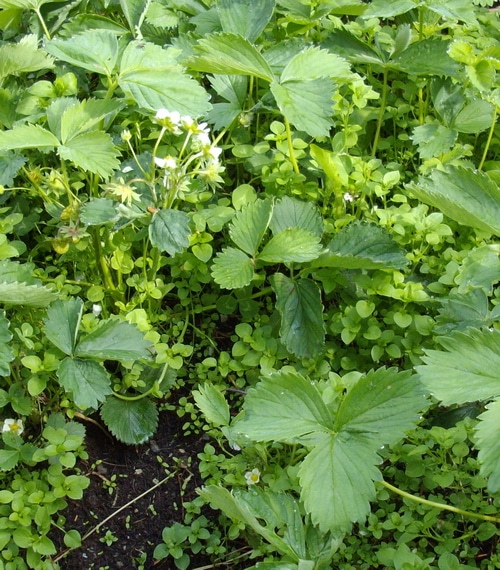

An inspirational blog for a beginner! I am determined (in the middle of January) to search out some of these plants (many of which i am familiar with already as weeds) and try them out.
Did harvest some dandelions a few years ago, but cleaning the leaves was so labor intensive that i became discouraged. Any ideas on easiest ways to process these plants?